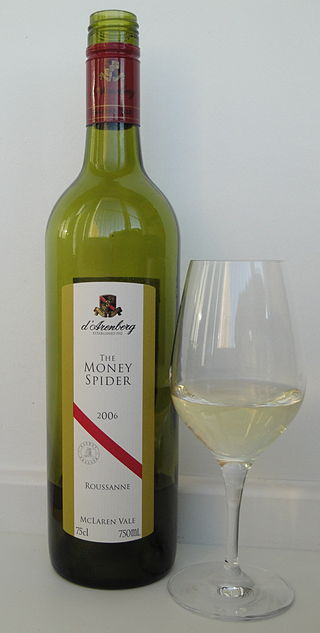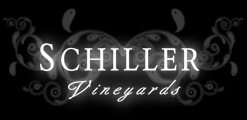
Syrah, also known as Shiraz, is a dark-skinned grape variety grown throughout the world and used primarily to produce red wine. In 1999, Syrah was found to be the offspring of two obscure grapes from southeastern France, Dureza and Mondeuse Blanche. Syrah should not be confused with Petite Sirah, a cross of Syrah with Peloursin dating from 1880.

Grenache or Garnacha is one of the most widely planted red wine grape varieties in the world. It ripens late, so it needs hot, dry conditions such as those found in Spain, where the grape is believed to have originated. It is also grown in the Italian island of Sardinia, the south of France, Australia, and California's Monterey AVA, Paso Robles, Santa Barbara County and San Joaquin Valley.

McLaren Vale is a wine region in the Australian state of South Australia located in the Adelaide metropolitan area and centred on the town of McLaren Vale about 38 kilometres (24 mi) south of the Adelaide city centre. It is internationally renowned for the wines it produces and is included within the Great Wine Capitals of the World. The region was named after either David McLaren, the Colonial Manager of the South Australia Company or John McLaren (unrelated) who surveyed the area in 1839. Among the first settlers to the region in late 1839, were two English farmers from Devon, William Colton and Charles Thomas Hewett. William Colton established the Daringa Farm and Charles Thomas Hewett established Oxenberry Farm. Both men would be prominent in the early days of McLaren Vale. Although initially the region's main economic activity was the growing of cereal crops, John Reynell and Thomas Hardy planted grape vines in 1838 and the present-day Seaview and Hardy wineries were in operation as early as 1850. Grapes were first planted in the region in 1838 and some vines more than 100 years old are still producing.

Torbreck is an Australian winery in the Barossa Valley, established in 1994. The winery was named one of the World's Top 100 Wine Estates by Robert Parker. The winery is named after a forest in Scotland where the original owner Dave Powell worked as a lumberjack. The wines are made in a style emulating those of the Rhône Valley and are made from various grapes including red grapes Shiraz, Grenache and Mataró as well as white grapes Viognier, Roussanne and Marsanne.

The Australian wine industry is one of the world's largest exporters of wine, with approximately 800 million out of the 1.2 to 1.3 billion litres produced annually exported to overseas markets. The wine industry is a significant contributor to the Australian economy through production, employment, export, and tourism.

Penfolds is an Australian wine producer that was founded in Adelaide in 1844 by Christopher Rawson Penfold, an English physician who emigrated to Australia, and his wife Mary Penfold. It is one of Australia's oldest wineries, and is currently part of Treasury Wine Estates.

d'Arenberg is an Australian wine company founded in 1912. All of its vineyards are located in South Australia's McLaren Vale wine region, although some of the wines they make are produced from grapes sourced from the Adelaide Hills wine region and other parts of the Fleurieu zone. It is now owned by the fourth generation of the Osborn family, headed by Chester Osborn. d'Arenberg are known for the quirky names of their wines, and their specialism in the vines of the Rhône valley. They also produce many of their wines in a traditional manner, using basket pressing for both reds and whites and leaving the vast majority of the red wines unfiltered and unfined which can cause the wine to throw a sediment in bottle but leaves the flavour intact. The majority of their red wines are suitable for ageing as well as for drinking fairly young and even the cheaper wines show very well after a few years in bottle. Perhaps their best known wine is 'The Dead Arm Shiraz', made from fungus-infected shiraz grape vines.
Accolade Wines is an international wine business with headquarters in South Australia and corporate offices in Melbourne. It has been owned by the Carlyle Group, an American private equity company, since 2018.

Schiller Vineyards located in the wine region of Barossa Valley, South Australia; was established back in 1864 when the first vines were planted by Carl Freidrich Schiller. Carl arrived in 1855 to South Australia and settled in the small Barossa village of Light Pass. Schiller Vineyards today is a sixth generation family owned and operated vineyard, and producer of aged red wines.
Coriole Vineyards is a winery located in the McLaren Vale wine region of South Australia.

The South Australian wine industry is responsible for more than half the production of all Australian wine. South Australia has a vast diversity in geography and climate which allows the state to be able to produce a range of grape varieties–from the cool climate Riesling variety in the Clare Valley wine region to the big, full bodied Shiraz wines of the Barossa Valley.
Clarendon Hills is an Australian winery founded in 1990 by Roman Bratasiuk.

Thomas Hardy was a winemaker in the McLaren Vale, South Australia. He has been called the "Father of the South Australian Wine Industry".
Pewsey Vale vineyard was founded in Eden Valley, South Australia during 1847 by Englishman, Joseph Gilbert. It is currently part of S.Smith and son. It was the first vineyard established in what is now the Eden Valley wine region and the first to plant Riesling vines in Australia. Pewsey Vale has become one of Australia’s leading producers of commercial riesling, with its signature wine being the Contours Riesling.

The Barossa Valley wine region is one of Australia's oldest and most premier wine regions. Located in South Australia, the Barossa Valley is about 56 km northeast of the city of Adelaide. Unlike most of Australia whose wine industry was heavily influenced by the British, the wine industry of the Barossa Valley was founded by German settlers fleeing persecution from the Prussian province of Silesia. The warm continental climate of the region promoted the production of very ripe grapes that was the linchpin of the early Australian fortified wine industry. As the modern Australian wine industry shifted towards red table wines in the mid-20th century, the Barossa Valley fell out of favor due to its reputation for being largely a Syrah from producers whose grapes were destined for blending. During this period the name "Barossa Valley" rarely appeared on wine labels. In the 1980s, the emergence of several boutique families specializing in old vine Shiraz wines began to capture international attention for the distinctive style of Barossa Shiraz, a full bodied red wine with rich chocolate and spice notes. This led to a renaissance in the Barossa Valley which catapulted the region to the forefront of the Australian wine industry.
Giaconda is an Australian winery in Beechworth, Victoria.
Kingston Estate winery was established in 1979 by Sarantos and Constantina Moularadellis.

Benjamin Cane is an Australian winemaker who currently owns Duke's Vineyard in the Great Southern region of Western Australia.

Force Majeure is a Washington/Oregon wine estate, specializing in Syrah, Cabernet Sauvignon as well as other Bordeaux and Rhone-inspired blends. The brand was founded in 2004, and beginning with that vintage began the "Collaboration Series" of wines made by some of Washington's top winemakers, using fruit from Red Mountain's Ciel du Cheval vineyard. Since 2014, the wines have been made by acclaimed winemaker Todd Alexander, who moved from the Napa Valley to the Pacific Northwest at that time. The brand labels also changed in 2014, to signify the winemaking change and the use of their estate vineyards for the wines, going forward. Todd Alexander continues to craft these limited production wines to this day.

Fleurieu zone is a wine zone located south of Adelaide in South Australia. It extends from Kangaroo Island in the west as far north as Flagstaff Hill on the west side of the Mount Lofty Ranges and to as far north as Langhorne Creek on the east side of the Mount Lofty Ranges. It consists of the following five wine regions, each of which has received appellation as an Australian Geographical Indication (AGI): Currency Creek, Kangaroo Island, Langhorne Creek, McLaren Vale and the Southern Fleurieu.















